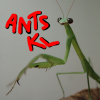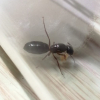1. Location of collection: Indianapolis Indiana, found on my driveway.
2. Date of collection (more important for ID's of queens). 7/14/21
3. Habitat of collection (ie: desert scrub, oak forest, riparian, etc.). Suburban residential area
4. Length (to the nearest millimeter or 1/16th of an inch.) 11mm
5. Coloration, hue, pattern and texture, Red head with black eyes, red and black thorax, black gaster
6. Distinguishing characteristics: Triangular head
7. Anything else distinctive : One feisty lady
8. Nest description N/A
9. Nuptial flight time and date: found without wings on 7/14, most likely a few days before then



















